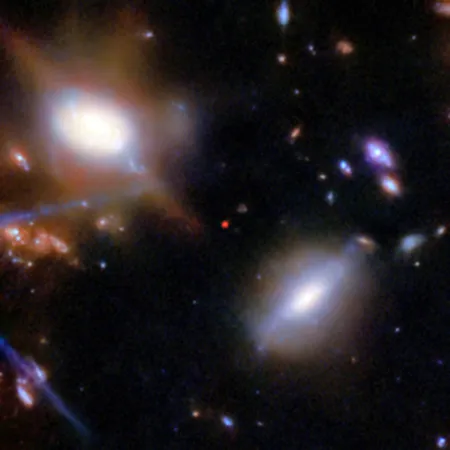
Early Galaxy Discovered Crafting Clear 'Bubbles' in the Foggy Universe
2025-04-07
Author: Benjamin
In the chaotic youth of the cosmos, conditions were anything but tranquil. After igniting in a massive cosmic explosion known as the Big Bang, the universe began to cool and expand, leading to the formation of matter under the influence of gravity. Vast clouds of gas slowly consolidated to give rise to the first galaxies, engulfed in a dense fog of neutral hydrogen that obscured their light.
This primordial fog posed a significant challenge for astronomers seeking to investigate these fledgling galaxies. Because this neutral hydrogen absorbed ultraviolet (UV) light, early galaxies nestled within this haze remained largely invisible, eluding detection until now. Understanding these early cosmic entities is crucial, as every glimpse inside the fog brings us closer to unraveling the universe's origins.
The Epoch of Reionization: A Radical Shift
The fog surrounding early galaxies didn't remain forever. The first generations of stars and galaxies began emitting UV light, which gradually ionized the surrounding neutral hydrogen, transforming the opaque cosmos into a more transparent expanse. This pivotal phase is referred to as the Epoch of Reionization, a time when light could finally traverse more freely across the universe.
For decades, researchers believed this reionization began a staggering half a billion years after the Big Bang and continued for an additional half billion years. However, groundbreaking research from the Cosmic Dawn Center (DAWN) proposes that this transformative process began much sooner than previously thought.
Discovery of JADES-GS-z13-1: The Galaxy That Lit the Way
The key to this revelation lies in the study of a galaxy named JADES-GS-z13-1, one of the earliest galaxies ever observed. Its extraordinary brightness stands out, drawing the attention of researchers like Joris Witstok from the University of Cambridge, who highlighted its unique emission of light known as "Lyman alpha."
This light, which stems from hydrogen, is particularly significant because it has remained undetectable from galaxies that originated less than 500 million years after the Big Bang—until now.
The Cosmic Bubbles: Reionization in Action
Witstok's team presents compelling evidence that JADES-GS-z13-1 engineered a local bubble of ionized space around it, effectively clearing a path in the overwhelming fog. This observation indicates that the reionization process was not only underway much earlier than expected, but our understanding of how the early universe functioned is now on shaky ground.
The emitted light from JADES-GS-z13-1 serves as crucial evidence that the early universe had begun to break free from its muted state much sooner than the established timeline suggested.
James Webb Space Telescope: A Gateway to the Past
Thanks to advancements in technology, particularly the capabilities of the James Webb Space Telescope (JWST), scientists gained unprecedented access to these distant galactic formations. The telescope’s sensitive instruments allowed for detailed analysis of JADES-GS-z13-1, revealing the complex interplay between galaxies and their environment during the universe’s genesis. Peter Jakobsen, one of the pivotal figures behind JWST’s NIRSpec tool, expressed excitement over the unexpected findings that challenge long-held theories.
The Next Frontier: Unraveling the Source of Ionization
Determining the source of the ionization that generated this bubble remains an enigmatic puzzle. It is speculated that the first hot, UV-bright stars could have played a significant role, yet the possibility of supermassive black holes emitting immense radiation as they consume gas emerges as another compelling explanation. Witstok notes that most galaxies contain these supermassive black holes, which could also contribute to the clearing of space around young galaxies.
As astronomers continue to probe ancient galaxies, we may be on the cusp of unveiling even more profound secrets regarding the mysterious early universe.
A New Understanding of Cosmic Evolution
The discovery of Lyman alpha light from JADES-GS-z13-1 and the evidence of ionized bubbles has massive implications for our comprehension of the universe's formative epochs. It challenges existing theories about galaxy formation, reionization, and the very timeline of cosmic evolution itself.
With enhanced observational tools like the James Webb Space Telescope, the potential for uncovering new truths about the early universe is limitless. The reionization process, now thought to have started significantly earlier than previously believed, could reshape our entire understanding of cosmic history.
As we peel back the layers of time through rigorous scientific exploration, the universe's mysterious infancy continues to reveal its treasures.
Stay tuned for more intriguing discoveries as we journey deeper into the cosmos, where reality often surpasses our wildest theories!









 Brasil (PT)
Brasil (PT)
 Canada (EN)
Canada (EN)
 Chile (ES)
Chile (ES)
 Česko (CS)
Česko (CS)
 대한민국 (KO)
대한민국 (KO)
 España (ES)
España (ES)
 France (FR)
France (FR)
 Hong Kong (EN)
Hong Kong (EN)
 Italia (IT)
Italia (IT)
 日本 (JA)
日本 (JA)
 Magyarország (HU)
Magyarország (HU)
 Norge (NO)
Norge (NO)
 Polska (PL)
Polska (PL)
 Schweiz (DE)
Schweiz (DE)
 Singapore (EN)
Singapore (EN)
 Sverige (SV)
Sverige (SV)
 Suomi (FI)
Suomi (FI)
 Türkiye (TR)
Türkiye (TR)
 الإمارات العربية المتحدة (AR)
الإمارات العربية المتحدة (AR)